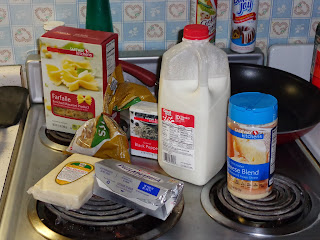I've decided to start another post series, this one about various recipes I cook. Before I went back to school, I used to be a professional chef. I've been told from several people that I'm rather good at it, and that I should post up some recipes. I've done this for several years on various forums I've gone to as the occasion arose, but now I'm gonna just post them all here... together with pictures I take as I cook them.
So, walnut cheese pasta. It's one of the better pastas I make. I found the recipe in an old Italian cookbook from the 60s or 70s, and tried it out when I was living in Portland. It was pretty awesome, so I'd make it regularly for myself and my roomies. And then one day, when I was working at a college cafeteria, we didn't have the ingredients for the pasta on the menu, so they asked me to whip up something. We had the stuff for this (minus the fontina cheese) so I made it, and then had to make something else after it was cleared out within an hour. And now I'm giving the recipe to you.
WHAT YOU NEED
From left to right, top to bottom: Farfalle pasta (the bowtie-looking things), walnuts (chopped, but not too fine... if you buy them whole, then chop them yourself), black pepper (ground is fine, but whole peppercorns are better if you can crack/grind them yourself), milk, grated Parmesan cheese (or similar cheeses; grated Asiago and/or Romano are fine too), fontina cheese, and an 8 oz. block of cream cheese. They're not pictured, but you'll also want some lemon juice and olive oil. (Get extra-virgin olive oil that's first cold pressed, otherwise you're throwing your money away.) If you can't find fontina cheese in your area, havarti is a good substitute, so is gouda or, worse comes to worse, mozzarella. But do try to find the fontina first: it's got subtle flavor notes that you'll want in this dish.
STEP 1: COOK THE PASTA
This is the easiest part. You have a box (maybe a bag?) of farfalle. There should be instructions on that bag. Follow them. It should look something remarkably like this when you do. You can do this step concurrently as you do the others, because it'll take a while for the water to boil and then for the pasta to cook.
STEP 2: PREPARE YOUR CHEESE
Grab your fontina cheese. Open 'er up, and dice up maybe like 1-2 oz. or so of it. If you bought it in the fancy cheese section of Safeway, and it looks similar to the one in the picture, you'll chop up about a fourth of it. Dice it into smallish cubes so it'll melt easier.
STEP 3: BY YOUR POWERS COMBINED, I AM A CHEESE SAUCE
Put like a cup of milk, the whole 8 oz. of cream cheese, and the fontina cubes in a fairly large skillet. Add a liberal sprinkling of Parmesan cheese and take your spatula and chop the cream cheese into cubes. Turn your stove up to medium heat. It'll take a few minutes for everything to melt. So stir it as it melts, and give your pasta a couple stirs too so it doesn't burn on the bottom.
STEP 4: I LIKE 'EM REAL THICK AND JUICY
You want the sauce to be relatively thick. You should be able to drag your spatula across the bottom of the pan and have it take a second for the sauce to fill in behind it, like in the pic. If the sauce is taking more than a second or two to do that, it's too thick and you need to add milk. If the sauce fills in behind the spatula right away, add more grated Parmesan and blend it in and keep doing that until it's thick enough to look like it does in the pic.
STEP 5: PEPPER THAT NOISE
I was trying to work a Beatles reference into that title but it failed. Add black pepper to taste and stir it around. Since this is an easy step, I'll use this space to tell you a trick to Italian cooking: red peppers go in colored sauces, and black and white peppers go in monochromatic sauces. Don't put red pepper flakes in a cream sauce, is what I'm saying. And for the love of God, black pepper has no business in marinara.
Anyway, this is it for the sauce, it's ready. If the pasta isn't ready yet, just put the sauce on low heat and stir it every now and then.
STEP 6: FINISH THE PASTA
Your pasta should be cooked about now. Drain it, and then toss the pasta with olive oil and lemon juice. It'll add some zest to balance out what would otherwise be a very heavy dish.
STEP 7: PLATE THAT STUFF UP
It's called walnut cheese pasta for a reason, but I always save them for last. See, walnuts don't need cooking; they're actually kinda gross when cooked. Add in all the allergies everyone has, and the fact that they kinda look best in this dish if they're added at the end, and there you go.
Dish up your pasta, then slather that sauce on top of it, and then add your walnuts. If you want to put Parmesan on top of that, go for it. I can't get enough of the stuff, and I love the mouthfeel of grated Parmesan, so I usually do, even though it's kinda redundant in this dish.
So yeah. Walnut cheese pasta. Now you know. Here's a handy-dandy infographic in case you wanna share this recipe somewhere.








beautiful!
ReplyDelete